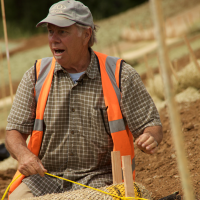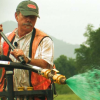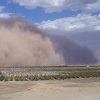
Establishing Soil Health and Vegetation Package
-
Register
- Non member - $225
- Professional member - $200
- Professional Plus member - $200
- Professional Plus Org member - $200
- Student member - $200
- Young Professional member - $200
- Emeritus member - $200
- Discounted Professional member - $200
- Australia Member - $200
- Australia Non-Member - $225
Seeking training on soil health and vegetation establishment? This seven (7) course package will provide you a variety of courses covering restoration of disturbed land, improving vegetation and infiltration, native plant establishment, bioengineering, soil stabilization, vegetation as an erosion control solution and soil health.
Courses:
- Sustainable Native Plant Establishment, Bioengineering & Successful Monitoring Methods
- Bioengineering and Biotechnical Soil Stabilization
- Improving Infiltration & Vegetation in Post-Construction Soils
- Vegetation ... The Permanent Erosion Control Solution
- Five Fundamentals of Successful Restoration of Disturbed Lands
- Soil Health and Erosion Control
Course Level: All
At the completion of all seven (7) courses you will receive 7 Professional Development Hour of credit. For any questions on continuing education credit, please contact IECA Education at education@ieca.org
-
Contains 4 Component(s), Includes Credits
Understand the guiding principles behind the Biotechnical techniques, the geotechnical benefits, the history, and the many important details necessary for a successful project.
This online course condenses nearly 20 years of authors’ experience into1 hour. The course includes fascinating facts about the history of bioengineering in the West. Where did the term “Straw Wattle” originate? Answers to the question about “design life” of biotechnical methods lie in understanding successional reclamation? Plus, this course will offer 4 of the most useful willow methods. For novices to experts, this course is a must for those interested in Bioengineering (AKA – Biotechnical Soil Stabilization). Understand the guiding principles behind the Biotechnical techniques, the geotechnical benefits, the history, and the many important details necessary for a successful project. Designers and implementers will improve your success. The techniques covered are applicable to both river and upland settings. Learn from past projects, proffered with the benefit of time and presented in straightforward manner.
Learning Objectives:
- Identify and summarize the concepts of Bioengineering.
- Summarize the history of Bioengineering.
- Explain the geotechnical, aesthetic and sustainable nature of the Bioengineering approach.
- Define the four fundamental and cost-effective methods for implementing willow cutting.
- Understand how the number bioengineering and biotechnical methods are very diverse – some are applicable for riparian zones and some are useful upland areas.
Course Level: Intermediate


John A. McCullah
John McCullah has an AA degree in Biology and a BS in Watershed Geology. He has CA contractors license since 1990 and has been performing erosion control and restoration work for over 25 years. John has been a Certified Community College Instructor since 1996, developing curriculum and teaching at Shasta College in No. California. John is a recognized expert in erosion control, stream and watershed restoration, and technical training.
He has had specialized adult educator training while teaching state-wide storm water courses for California Department of Transportation - from 2001 through 2011. John is also certified as a QSD and QSP (Qualified SWPPP Developer and Practitioner) and he is a Trainer of Record for these CA professional requirements. He has authored 3 complete Best Management Practice Manuals and helped develop new BMPs with California Department of Transportation Division of Landscape Architecture, particularly Steep and Adverse Slopes. John has been teaching professional development courses for IECA since 1996. His popular ‘Best of the BMPs’ course is constantly being updated to reflect new technology, materials, and practices. The Dirt Time video series was produced as a means to present hands on learning experiences to the classroom. There are now over 15 Dirt Time episodes and 50 video clips available.
John has designed and built many environmentally-sensitive river and stream projects over the last years, projects ranging from California to Alaska, and Alberta Canada to New Zealand. As an academic and practitioner with dozens of case studies and Dirt Time clips, John’s trainings are filled with first hand, practical experiences. He recently co-authored Bioengineering Case Studies - Sustainable Stream Bank and Slope Stabilization published in 2015 by Springer.
At the completion of this course you will receive 1 Professional Development Hour of credit. For any questions on continuing education credit, please contact IECA Education at education@ieca.org
-
Contains 5 Component(s), Includes Credits
This course on Native Plant Establishment includes elements and methods for developing a well-thought-out native vegetation establishment program.
Part one of a two module course about Native Plant Establishment and includes elements and methods for developing a well-thought-out native vegetation establishment program. In this first module, participants will learn why native plants are better than non-natives, what makes a good erosion control species, how to select plant species specific to their regions that can best control erosion and sediment transport, how to develop a suitable seed mixture of species, the pros and cons of different seeding techniques, and methods to ensure the success of your plan. The course is taught by an experienced restoration ecologist with over 35 years’ experience, and countless projects, some of them award winning, under his belt. The course is suitable for beginners to experts, and all will find something of value in the information provided.
Part two of a two module course about Native Plant Establishment. In this second module the focus is on addressing the importance of seeding and planting methods, and soil amending, as well as post planting monitoring. This part of the course will help participants identify and understand how to address various problem soils that are commonly encountered. In addition, monitoring methods are discussed and participants will learn how to prepare a monitoring plan suitable for most jurisdictions. Part Two is taught by the same experienced restoration ecologist with over 35 years’ experience, and countless projects, some of them award winning, as Part One. The course is suitable for beginners to experts, and all will find something of value in the information provided.
Learning Objectives:- Know what seeding and/or planting methods are appropriate for your site
- Be able to identify a problem soil and know some techniques for addressing the issues
- Be able to prepare a monitoring plan that will identify problems in establishment
- Understand why native plants might be required
- Know what makes a “good” erosion control species
- Know how to make a seed mixture that will survive your conditions
Course Level: All

Tom Williams, MA, CPESC
Mr. Williams has over 30 years’ experience in the project management and preparation of erosion and sediment control plans, reclamation plans, baseline data collection, permitting and environmental impact assessments. The majority of the projects he has participated in have been mining, transmission and pipe line related. Mr. Williams has a Master’s Degree in reclamation ecology and is a CPESC with specific expertise in the reclamation and revegetation of drastically disturbed mined lands, statistical analysis of vegetation, and erosion and sediment control. Mr. Williams has conducted training courses on vegetation establishment, revegetation, erosion control, and environmental impact assessment for over 30 years. He is a past IECA Director and the Chair of the SOIL Fund and Technology Section 3, Vegetation Establishment subcommittees, and is the Vice President of Environmental Affairs for Midway Gold US Inc.
At the completion of this course you will receive 1 Professional Development Hour of credit. For any questions on continuing education credit, please contact IECA Education at education@ieca.org
-
Contains 4 Component(s), Includes Credits
When we build things, we also tend to destroy the surrounding soil so that it sheds water like a parking lot and establishing plants is nearly impossible. This course provides insights into methods to restore the soil so that it can soak in rainfall and provide good growing conditions.
The process of constructing roads and buildings involves heavy equipment grading the land to provide for its new purpose. By the time construction is complete, the soil has been severely disturbed so that what remains is often a dense, low-fertility material that can absorb little rainfall and which plants find inhospitable. This course will describe a variety of methods to reverse this conditions and even turn vegetated areas into stormwater absorption zones. After the problem is defined, the instructor will review mechanical methods to address compaction and a number of amendments that are commonly used. Recent studies of tillage and amendment effects on infiltration and grass growth will be reviewed to provide evidence of how successful these remediation approaches can be to reduce runoff from built areas.
Learning Objectives:
- Terminology used to describe soil and soil condition, understanding what "good" and "bad" values are for soil properties.
- Knowledge of the range of options for soil treatment and the likelihood of success.
- Understand the effect of tillage, depth of tillage, and amendments on vegetation growth, soil compaction, and infiltration.
- Understand the benefits of tillage on infiltration.
- Understand the major factors in successful soil treatment for infiltration as well as factors we have to investigate further.
Course Level: All

Richard McLaughlin, Ph.D.
Raised in Maryland, Dr. McLaughlin attended Virginia Tech for his undergraduate degree in Natural Resource Management. He then studied forestry, soils and soil chemistry at Purdue for his Master's and Ph.D. After 2 years as a post-doctoral researcher at North Carolina State University, he was hired by Ciba-Geigy in Greensboro as a Senior Scientist. After five years of excellent pay and benefits, he returned to NC State in 1993 to conduct applied research and extension education in water pollution prevention. His group has conducted extensive research into improved methods of erosion, sediment, and turbidity control and has trained thousands in standard and advanced practices on construction sites. His Outreach program received the 2010 Education Award from the International Erosion Control Association and his research program received the Applied Research Award from the Soil Science Society of America in 2011.
At the completion of this course you will receive 1 Professional Development Hour of credit. For any questions on continuing education credit, please contact IECA Education at education@ieca.org
-
Contains 4 Component(s), Includes Credits
Soil health is quickly becoming a topic of international concern. Internationally, lack of soil health negatively effects the quality of life in many countries due to reduced food production, decreased water quality, and increased soil erosion issues.
Today, more than ever, we understand the importance of soil health. Soil health is quickly becoming a topic of international concern. Internationally, lack of soil health negatively effects the quality of life in many countries due to reduced food production, decreased water quality, and increased soil erosion issues. The effects of poor soil health can be lessened or eliminated through education, awareness, and ultimately the adoption of Soil Health Best Management Practices (BMP). In this webinar, Rhett K. Kerby, M.S. will offer real world examples of soil health identifiers and discuss how Soil Health BMPs can be implemented to improve soil health and reduce erosion.

Course Level: All

Rhett Kerby
Rhett provides reclamation/native seed consultation regarding seed bed preparation, seed application methods, seeding rates, species selection, weed control methods (chemical and mechanical), soil health, and erosion control to numerous industries. Consultation clients include: Professional Engineers, CPESCs, SWPPP administrators, Environmental Consulting Firms, Landscape Architects, District Conservationists and Rangeland Management Specialists, Oil and Gas contractors, Mining contractors, DOT Vegetation specialists, Hydromulch contractors, Wildlife Biologists, and State/County/City government officials
At the completion of this course you will receive 1 Professional Development Hour of credit. For any questions on continuing education credit, please contact IECA Education at education@ieca.org
-
Contains 4 Component(s), Includes Credits
This course will focus on the use of native plant materials as the primary and long term solution to limiting excessive erosion on large and small scale projects. Participants will be made aware of seed collection techniques and why select seed species may not be available from year-to-year.
This course will focus on the use of native plant materials as the primary and long term solution to limiting excessive erosion on large and small scale projects. Participants will be made aware of seed collection techniques and why select seed species may not be available from year-to-year. Participants will learn the major components of effective vegetation planting plan and how to compliment short term erosion control products to fulfill long term vegetation strategies. The Webinar will tie in available planting methods, conservation practices and erosion control materials into successful rehabilitation/restoration outcomes. Multiple case histories will be presented showing the effectiveness of plant materials to minimize the impacts of excessive erosion following disturbances.

Learning Objectives:
- Understand and describe the challenges of seed collection and availability.
- Ability to develop an effective planting plan.
- Describe how to combine common sense conservation practices, short term erosion products and vegetation (seed) into successful reclamation outcomes.
Course Level: All

William Agnew, CPESC, M.S.
William Agnew is the owner of Agnew Environmental Consulting and innovative consulting firm catering to the needs of the seed and erosion control manufacturing industry. William has a BS in Wildlife Biology and MS in Range Management both from Colorado State University. William is a CPESC and is responsible for/contributed to over 25 publication.
-
Contains 5 Component(s), Includes Credits
Those overseeing land rehabilitation efforts should integrate the five fundamentals for successful land restoration into their projects. This presentation will provide details on the five fundamentals along with real world examples of success and challenges.
Successful restoration of disturbed land requires a comprehensive and holistic approach. Those overseeing rehabilitation efforts should assimilate and stage several considerations into a working relationship that integrates five fundamentals for successful land restoration. Employing the discipline to work through the discovery sequence of the first three fundamentals – to analyse soils and substrates, pick the right plant materials for the site and select the most cost effective erosion and sediment control techniques, will undoubtedly lead a project in the right direction.
These fundamentals must be followed by the development of clear and comprehensive construction plans and specifications to effectively communicate the project requirements to contractors and installers. Once construction commences, onsite oversight of acceptable installations must be conducted by qualified inspectors knowledgeable of the site conditions. Then, active rehabilitation sites must be regularly inspected and maintained after each significant precipitation or other potentially damaging events. Inspections should be conducted by qualified professionals whose expectations are consistent with the installer as well as the owner and regulatory entity(s). Failure to systematically execute on any of these fundamentals can undermine the best laid plans of any land restoration project.
Many disturbed sites offer unique and unpredictable challenges for successful land restoration efforts. Published handbooks or manuals can provide general approaches to land reclamation, but rarely can they address the specific needs or conditions of unique sites. Successful restoration most typically comes from carefully controlled onsite trials and iterative installations to assess efficacy of various treatment combinations. Such treatments must then be refined and customized to develop cost effective plans. Exhaustive research on suitable soil amendments, plant materials and erosion control techniques should be planned and budgeted for – as integral steps in the project progression.
Several selected case studies from around the world are highlighted – demonstrating diverse climates with contrasting environmental and site conditions will be offered to illustrate the discovery (required information gathering) and implementation (execution) of the five fundamentals for successful land restoration.

Learning Objectives:
- Attendees will receive detailed instruction regarding the science, practice and implementation for five fundamentals integral to successful erosion control and revegetation.
- Attendees will learn how to integrate and stage these fundamentals into holistic and comprehensive rehabilitation plans that entail proper planning and execution.
- Case studies demonstrating successful implementation of the five fundamentals will provide attendees examples and ideas for consideration on their future projects.
Course Level: All
Last Updated: August 16, 2017
-
Contains 4 Component(s), Includes Credits
This webinar will focus on the important role that vegetation plays in stormwater management during and after construction and will present new guidance developed in Colorado that covers many fundamentals of successful revegetation and could be adapted to other regions.
Vegetation is Nature’s best management practice (BMP) for controlling erosion, yet when we discuss BMPs, we are often focused on structural practices that reduce erosion and/or remove sediment. This webinar will focus on the important role that vegetation plays in stormwater management during and after construction and will present new guidance developed in Colorado that covers many fundamentals of successful revegetation and could be adapted to other regions. Dr. Earles will discuss the different hydrologic, physical and biological processes that make vegetation an effective BMP. Students will leave the webinar with a renewed appreciation for vegetation and the key role it plays in effective stormwater management.

Learning Objectives:
- Understand the physical, biological and hydrologic processes that vegetation provides that help to manage stormwater runoff.
- Learn about the methods and steps to be successful with revegetation from soil testing to amendments to understanding the hydrologic setting.
- Learn about the benefits that urban trees can provide for long-term/post-construction stormwater management as well as limitations.
Course Level: All

Dr. T. Andrew Earles, Ph.D., P.E., D.WRE
Vice President
Wright Water Engineers, Inc.
Dr. Andrew Earles is the Vice President of Water Resources with Wright Water Engineers, Inc. (WWE) in Denver, Colorado. Andrew has worked for WWE for 22 years since receiving his doctorate on projects related to stormwater management, hydrology, hydraulics, water quality, flooding, and related topics. While most of Andrew’s projects are in the western U.S., he has performed work around the work related to stormwater management and flooding at World Heritage Sites in Peru, Cambodia, Thailand, China, and Iraq. Andrew earned his bachelor’s degree in Civil Engineering from Stanford University and hold master’s and doctoral degrees in Civil and Environmental Engineering from the University of Virginia.









